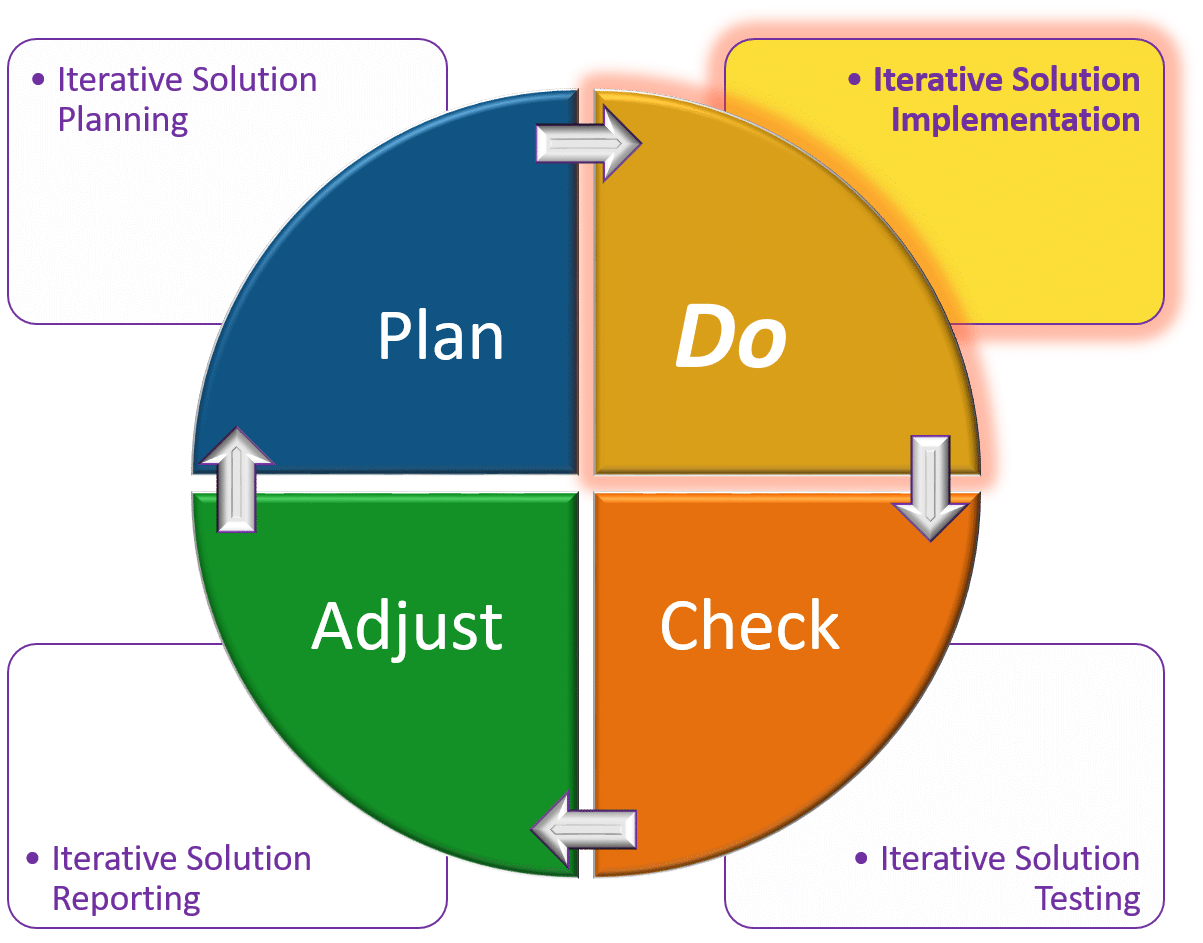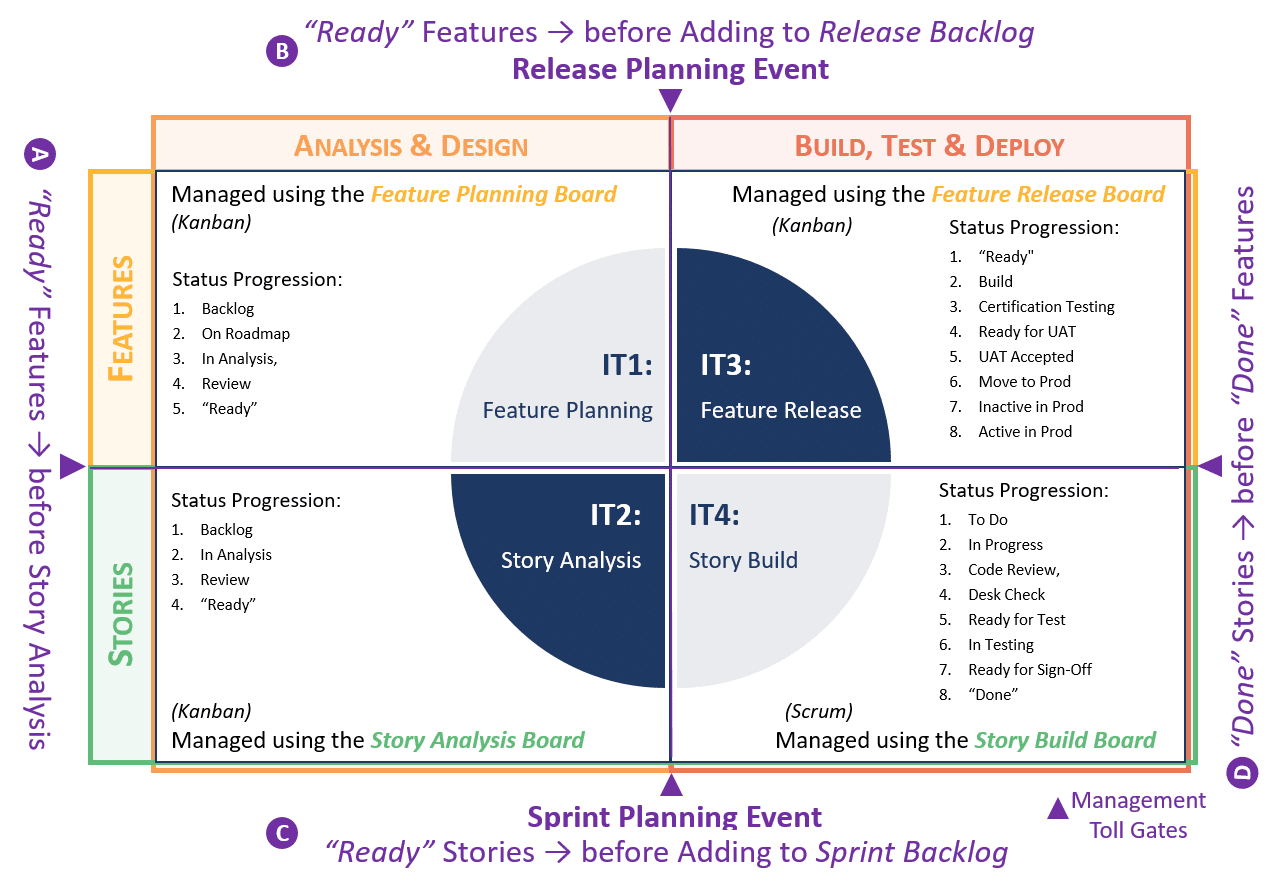The prior ITM section on Iterative Solution Planning described how to plan individual Solutions. Plans range from broad, multi-year horizons, down to detailed, daily efforts. Correspondingly, this section expands upon the planning tasks introduced, to describe the fundamental tasks needed to effectively, and efficiently, turn plans into results. These tasks comprise the second part of Solution Delivery - Iterative Solution Implementation. Finally, any Team can use of the four, concurrent, iterative cycles introduced here to successfully deliver Solutions of all types.
After the Overview below, explore the following in more detail:

Section Overview
Introduction
Implementation is about executing the work planned. Iterative Planning describes what is to be done, and when. Concurrently, Iterative Implementation describes how it is to be done, and by whom. Together, planning and implementation guide Solution Delivery efforts.
Like Planning, which uses five (5) Planning Levels (PL1 - PL5) to organize the tasks within each Solution's planning effort, Implementation uses four (4) Implementation Tasks (IT1 - IT4). Each task coordinates the actions, efforts, and personnel, involved in Solution Delivery.
Most tasks are the same regardless of Solution Type. However, there is some variance between Product & System delivery. This is due to the increased complexity of Product-type solutions. That said, this section describes the most complex delivery type - Products. Comparatively, other types can scale down, and/or drop, some steps that are not appropriate for their Solution Type. The pages in this section hightligh such variances.
This is the second of four activities which comprise the Plan-Do-Check-Adjust (PDCA) cycle. Variations also refer to this as Plan-Do-Check-Act, and Plan-Do-Study-Act. Regardless of the name used, the fundamental use of this systematic process is to drive continuous improvement. In this case, it is to improve Solution Delivery. That is, to attain greater productivity, as lessons are learned, and incorporated into implementation tasks. Further, the process will also provide better value and quality over time.
Objective
Implementation facilitates the definition, development and delivery of Features and Stories as part of overall Solution Delivery. Implementation segments work into two parts - what occurs before Planning Events, and what occurs after Planning Events. Before is about making Featues & Stories "Ready" for selection into a Release Planning Event, or Sprint Planning Event. After is about working all items chosen for a Release (Features) or Sprint (Stories) until they are "Done".
The term for making Features & Stories "Ready" for delivery is 'Refining' ( or 'Grooming'). Two tasks manage refinement, one for Features, another for Stories. To emphasize, this is the time during which a Team conducts most Analysis & Design (A&D) for the Solution. To illustrate, these tasks appear in the left column of the diagram below. As noted by the Toll Gates at the top and bottom of the diagram, the steps within these tasks manage the work done before the Release Planning Events and Sprint Planning Events.
Two additional tasks manage taking Features & Stories from "Ready" to "Done". Again, there is one task for Features, and another task for Stories. To emphasize, this is the time when a Team implements change - configurations are made; code is developed, validation occurs. To illustrate, these processes appear to the right diagram, in the column titled Build, Test & Deploy (BTD). Also, as noted by the Toll Gates at the top and bottom of the diagram, the steps within these tasks manage the work done after the Release Planning Events and Sprint Planning Events.
Key Point:
Implementation requires the coordinated efforts of many participants. Expecting Project Managers, or similar roles, to orchestrate everyone's efforts will significantly constrain Solution Delivery. Rather, allow standardized process and transparancy to enable each participant to function at their capacity.
Big Picture Context
To provide some context as to where are we in the Big Picture:
- If the Solution is a Product or Service which supports one or more Business Processes, then Team(s) completed Business Process Definition(s) for each process for which some Action (Process, Activity, Task) is within scope of the current Solution Phase;
- Solution Strategy & Architecture activities for the current Phase are complete. Their outputs provide relevant inputs to ongoing Iterative Solution Planning and Iterative Solution Implementation tasks; and
- Level 1 and Level 2 Planning are complete, with the Solution Roadmap updated.
In reality, the above efforts establish Solution Delivery objectives, as well as guide implementation efforts. Thus, completing each prior to Phase Inception, when long-term scope is set, is vital. Afterwards, the medium-term Release and short-term Sprint cycles to achieve the long-term scope get underway. In other words, untile the above activities are complete, Solution is not yet ready to begin ongoing, iterative Solution delivery cycles.

After reviewing the Parts within this Section shown at the top of the page, the next section to review is Iterative Solution Testing.
